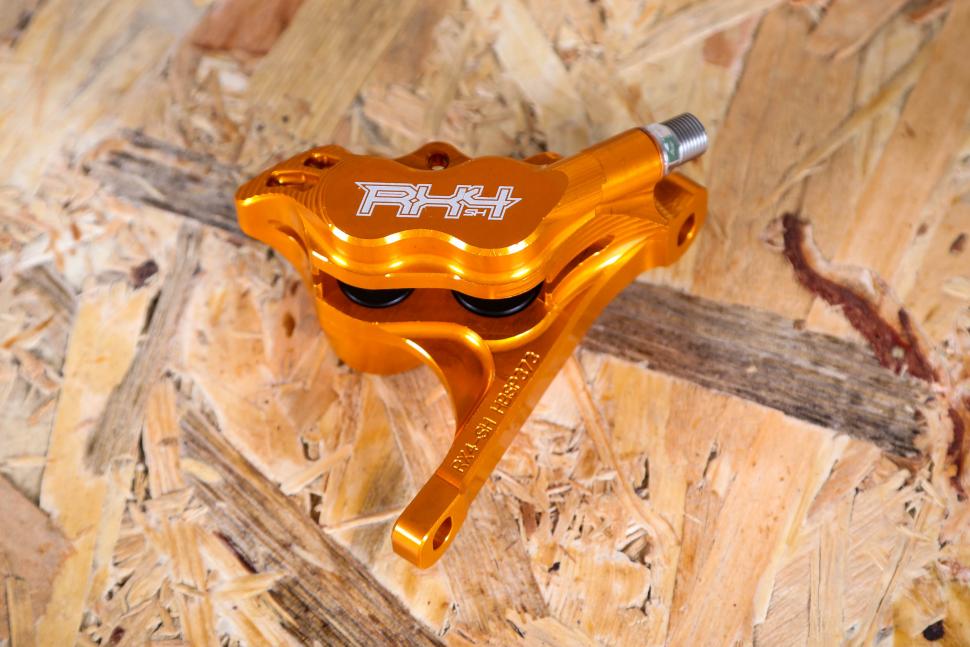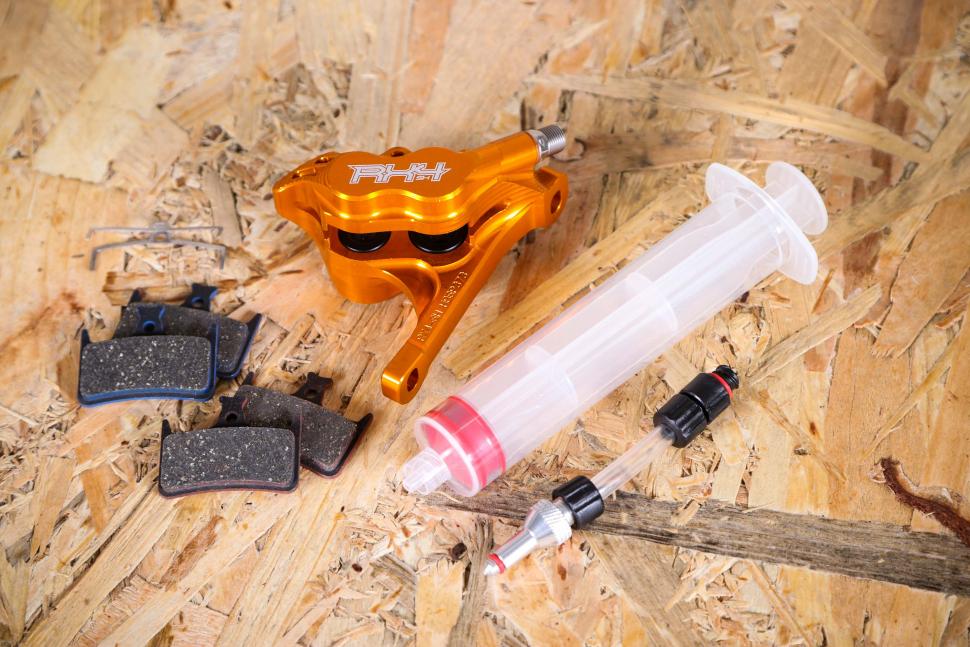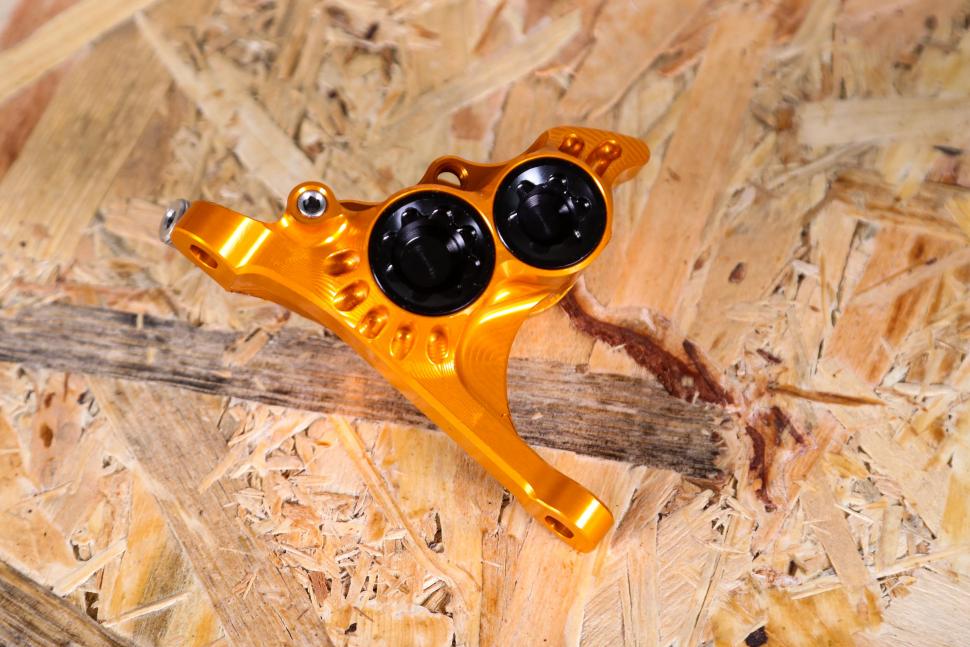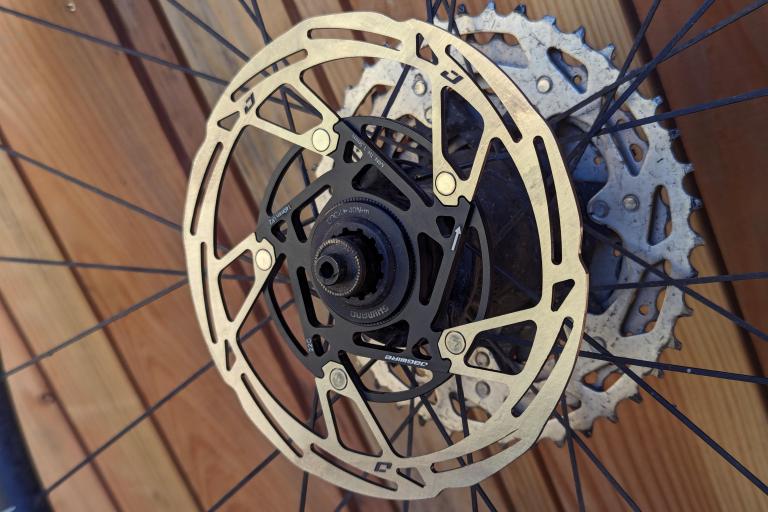- News
- Reviews
- Bikes
- Components
- Bar tape & grips
- Bottom brackets
- Brake & gear cables
- Brake & STI levers
- Brake pads & spares
- Brakes
- Cassettes & freewheels
- Chains
- Chainsets & chainrings
- Derailleurs - front
- Derailleurs - rear
- Forks
- Gear levers & shifters
- Groupsets
- Handlebars & extensions
- Headsets
- Hubs
- Inner tubes
- Pedals
- Quick releases & skewers
- Saddles
- Seatposts
- Stems
- Wheels
- Tyres
- Tubeless valves
- Accessories
- Accessories - misc
- Computer mounts
- Bags
- Bar ends
- Bike bags & cases
- Bottle cages
- Bottles
- Cameras
- Car racks
- Child seats
- Computers
- Glasses
- GPS units
- Helmets
- Lights - front
- Lights - rear
- Lights - sets
- Locks
- Mirrors
- Mudguards
- Racks
- Pumps & CO2 inflators
- Puncture kits
- Reflectives
- Smart watches
- Stands and racks
- Trailers
- Clothing
- Health, fitness and nutrition
- Tools and workshop
- Miscellaneous
- Buyers Guides
- Features
- Forum
- Recommends
- Podcast
review
£200.00
VERDICT:
Lightweight, bling and serviceable way to get more power from your brakes, with quite some faff
Fully serviceable
Powerful
Looks fabulous
Made in the UK
Lighter than the two-piston GRX alternative
The Devil's own setup procedure
Close tolerances mean occasional rubbing is inevitable
160mm rotors only
Inevitable 'Lancashire hotpot' references
Weight:
348g
Contact:
At road.cc every product is thoroughly tested for as long as it takes to get a proper insight into how well it works. Our reviewers are experienced cyclists that we trust to be objective. While we strive to ensure that opinions expressed are backed up by facts, reviews are by their nature an informed opinion, not a definitive verdict. We don't intentionally try to break anything (except locks) but we do try to look for weak points in any design. The overall score is not just an average of the other scores: it reflects both a product's function and value – with value determined by how a product compares with items of similar spec, quality, and price.
What the road.cc scores meanGood scores are more common than bad, because fortunately good products are more common than bad.
- Exceptional
- Excellent
- Very Good
- Good
- Quite good
- Average
- Not so good
- Poor
- Bad
- Appalling
Hope's road/gravel-specific RX4 calliper is a thing of powerful, serviceable beauty. Made in the UK and available in six colours, it does take quite some fettling to set up and will make more noise than you might like. One for the purists willing to invest in setup and maintenance.
For the last 30 years Hope of Lancashire has been at the cutting edge of bike performance. Introducing many world-firsts across braking, hub and headset technology, its products have graced the bikes of many world-level racers and winners. Its ethos of 'build the best or don't bother' has pushed the company to constantly evolve and fine-tune products for riders and racers looking for every advantage.
> Find your nearest dealer here
In the RX4 calliper, Hope has brought its thinking into the drop-bar gravel/adventure bike sphere, with four-piston callipers designed specifically to work with drop-bar levers from Shimano, Campagnolo and SRAM. These are different models/internals to cope with different brake fluids – mineral for Shimano/Campag and DOT for SRAM. Aside from using different types of rubber in the seals, the only difference is that the SRAM version uses two identical-sized pairs of pistons in each four-pot calliper, whereas the Shimano/Campag version on review here uses a larger and smaller pair – the difference being down to different lever fluid mechanics.
On Hope's website the RX4 is listed as not being compatible with the higher-spec Di2 levers in the Shimano GRX range. This is apparently because the Di2 lever uses Shimano's 'Servowave' technology, which makes the pads travel faster at the start of the lever throw, then increases the power once they make contact. Some have had success setting up the RX4 on Di2 levers, and Hope is in the process of testing a set of Di2 levers for compatibility. Stand by.
Of course nothing is ever that easy – Shimano's V3.2 tech doc dated Nov 2020 says that the 810-series GRX mechanical levers *are* Servowave, but Hope lists them as compatible. I have a mix – my front lever is a non-Servowave 600, my rear lever is the Servowave 810 dropper post actuator. Yes, there is a slight difference in feel, but to be honest it's not much and the bleed process was no different. What seems silly is that Hope lists a number of other Servowave levers on its chart as compatible (Di2 9170, for example). Usual disclaimers re always following the manufacturer's advice not withstanding, my bike hasn't caught fire yet, and I've not gone over the bars while stopping or over a fence at the bottom of a brakeless descent.
Hope CNC-machines its brakes (and pretty much everything else) in-house from single blocks of alloy, then anodises them in one of six bling colours. Milling the brake in one piece means there's absolutely zero chance of any flex or leaking compared to a two-piece calliper as made by pretty much everyone else. This does leave you with the challenge of how to get the pistons in – which is why there are two black piston bore caps that can be removed with a dedicated tool for servicing. We'll get to that later.
In the box
In the box you get the calliper, brass hose olive/insert, calliper bolts, two sets of pads – red organic and blue metallic – plus a high-quality syringe and bleed port adapter. You also get a pair of alloy pad spacers for the bleed process. There's a sheet of instructions, but you'll really be wanting the video on Hope's website to get the bleed process nailed.
Unlike Shimano, the front and rear callipers are markedly different and are not interchangeable. They are also only good for 160mm rotors, so aimed more at the gravel-adventure-touring crowd than minimalist-pure roadies. You don't need an adapter for the front calliper, it bolts direct to the fork and really does look cool. Hope also does a post-mount version if your frame or fork is older.
Comparing weights, the RX4s are pretty light – the front is 100g, the rear is 85g. Adding in pads and fittings at 25g a pair, I make them 235g all up, compared with 280g for two GRX callipers with finned pads and 160mm adapters. What's amazing is that they are lighter than a calliper with half the pistons and smaller pads.
Installation and setup
I installed them reusing the Jagwire hose I'd previously run my GRX callipers with, no problem. The provided brass hose insert and split olive went on easily, and with care are reusable. There's no torque spec on the shroud nut, but 8Nm seemed about right and hasn't leaked since.
The setup process really is a multi-cup-of-tea/beer duration. You will make more mess than you thought possible in a brake bleed, and you'll need to have spare fluid handy because if you muck it up you'll be starting all over. I really wouldn't want to be doing this bleed with the SRAM version – the idea of that much DOT fluid all over the place is not appealing.
Hope recommends it to be done with the calliper off the bike and hanging vertically down from the lever, so you don't leave air behind any of the pistons. With twice as many pistons as Shimano to clear, it's quite a faff. Notably, the process involves using the two alloy bleed blocks to advance each side almost fully out, bleed to remove air, then push back in and repeat on the other side. The bleed blocks don't fully space the pistons, so calliper alignment is down to your eye and a line marked down the centre of the calliper, which, strangely, is not mentioned in the instructions but is quite handy.
Basically, what you are doing is the exact opposite of how a Shimano or SRAM calliper is aligned. In their systems you squeeze the lever, both pistons advance, then you secure the calliper in the hope that when the pistons retract equally the rotor will be centred. In the Hope system you centre and secure the calliper, then fine-tune the pad advance on each side to get them equidistant from the rotor.
Like I said, be prepared with backup tea/beer – and maybe some colourful language. Critically, the rotor must not move when squeezed by the pads, or one side will always be closer, and more likely to rub.
And there's the rub. Ahem. Because there are four pistons doing the job that two do in the callipers the levers are designed for, logically they cannot travel as far for the same lever throw/fluid pump. So the clearances are not as good, there's less room for error, and less room for any grit/cack that might get betwixt pad and rotor.
Better braking?
Hope advises that you give it a few good rides for the system to settle down, and I can vouch for that. On my first ride, every puddle, every mucky bit was destined to send the RX4s into a state of noisy, gritty consternation, only settling down after material had either been abraded away or ejected.
At the same time there was no noticeable gain in raw power or modulation – the ability to progressively increase stopping power over the lever's stroke. Whether this was down to pad burn-in, clearance or otherwise I don't know, but I was pretty unimpressed at first, with stopping power being no better than standard GRX.
> 12 essential braking tips – get better control on hills & stopping
Then after a few rides things settled down, and the power did improve. I was able to comfortably come to a stop with one or two fingers over the top of my GRX810 levers, hands still on the hoods. In the drops, one finger could lock both wheels no problem.
I'd like to say the issue of gritty pickup disappeared, but through mucky sections it reoccured, albeit not as badly as on the first rides. I've stuck with the red organic pads, as I prefer quietness and the power has been plenty. Also, it's never remotely hot enough round here that heat dissipation is a performance issue.
Repair and maintenance
Maintenance-wise, Hope sells replacement seals (£7.40 a set), pistons (£5 each) and the tools to replace them. The only reason you'll need to replace a piston is if you've been brutal with a tool while working on the pistons and chipped one, so go easy, as per any calliper.
You need the two differently sized bore cap tools (£8 each) to remove the caps – for the low price don't try to bodge it.
For the SRAM version you only need the one cap tool. Hope recommends using Hunter silicone lubricant on the seals, at every pad change. Be sure to do this after thoroughly cleaning the piston and surrounds so you aren't simply shifting dirt into the seal.
> Everything you need know about disc brakes
Seals need replacing when either the pistons aren't retracting smoothly or fluid starts leaking. A pro tip is to pump out the inner pistons first – if you remove the bore caps and the outer pistons first you'll never get the inner ones out as the system won't be pressurised any more. An airhose can help if a piston is really stuck, but take care you don't create projectile weaponry.
Hope advises not to use brake cleaners, to avoid harming the seals. For burning the brakes in you can follow the default 10-stop bedding process, but don't do a single long descent. Another option is to just ride your bike normally, let them get dirty, put up with the noise and they will bed in eventually.
Conclusion
For my riding needs the Hope RX4 is maybe overkill. I weigh 75kg, and didn't use my gravel bike for heavy load carrying during the review period – that's what the winter-friendly fatbike is for. If you are a heavier rider, run a tandem and/or plan to do lots of loaded riding in steep country, the additional power and heat dissipation the RX4 provides could prevent knackered hands or sketchy can't-stop-won't-stop moments.
Then there are the aesthetics – available in six colours, you can mix and match to your heart's content with Hope's matching six-colour rotors and lockrings. And of course there's nothing saying both callipers need be the same colour either. Repairability is a plus as well.
At £100 per end the RX4s aren't cheap – but then they aren't ridiculous either, with the 800-spec two-pot GRX calliper costing £70. Brexit and the global bike boom/channel doom means availability of Asian-sourced components is a potential nightmare, so more people may be shopping local with Hope. Shimano doesn't do a four-pot flat mount calliper, so Hope is literally the only game in town I know of if you need more power than stock.
Hope makes the best brake it can make for a set use case, in one version only. That's it. It doesn't do tiers of product. The company stands behind its gear for many years, and many parts are interchangeable across the range like hose fittings, seals and pistons. While it might be a small brand, chances are any dealer will have what you need.
There's no avoiding it, the RX4 is a finicky beast that rewards attention to detail with better stopping performance and doesn't let you forget what you've bought into. If this sounds like your multi-cup fettle of tea you won't be disappointed, and your bike will look fabulous to boot.
Verdict
Lightweight, bling and serviceable way to get more power from your brakes, with quite some faff
road.cc test report
Make and model: Hope RX4 flatmount front and rear brake callipers
Size tested: n/a
Tell us what the product is for and who it's aimed at. What do the manufacturers say about it? How does that compare to your own feelings about it?
Hope says: 'The RX4 caliper builds on 25 years' experience designing and manufacturing hydraulic disc brakes and transfers the knowledge and skills acquired into the world of Road and Cyclocross dropbar brakes. A precision CNC machined monobloc design results in a stiffer caliper to give unrivalled feel and modulation. Choose from Shimano or Sram depending on your lever.'
Tell us some more about the technical aspects of the product?
Hope lists:
Key Features
Front flat mount hydraulic caliper to suit dropbar set ups
Shimano or Sram specific caliper
Slimline 4 piston lightweight design
Monobloc design creates a stiffer caliper reducing the fuzzy lever feel and brake pad rub
Available in Black, Silver, Red, Blue, Purple and Orange
Top entry pad fitting
CNC machined from 2014 T6 aluminium
RX4-SH Caliper - Designed to work with Shimano and Campagnolo dropbar brake systems
(Mineral Oil, Shimano recommended for Shimano application, Campagnolo/Magura recommended for Campagnolo)
Dura Ace Di2 R9170
Dura Ace R9120
Ultegra Di2 R8070
Ultegra R8020
105 R7020
Di2 R785
RS685
GRX RX810
GRX RX600
GRX RX400
Not currently compatible:
GRX RX815 Di2
GRX RX817 Di2
Campagnolo Compatible Calipers (RX4 SH)
Super Record
Record
Campagnolo H11
RX4 SH - 122g Inc pads
Rate the product for quality of construction:
10/10
Gorgeous CNC machining and anodising.
Rate the product for performance:
7/10
If you need more stopping power, they definitely deliver, but at the price of setup hassle and on-ride noise.
Rate the product for durability:
8/10
Given they are fully repairable while Shimano's callipers can't be fixed, Hope really win here.
Rate the product for weight (if applicable)
10/10
Excellent – four pistons for less weight than two.
Rate the product for comfort (if applicable)
9/10
If 'comfort' means 'comfort of hands whilst in use' then yes – less hand fatigue thanks to more power.
Rate the product for value:
5/10
Can't deny, these are pricey, but for £100 an end they're worth the money. You get the bleed syringe and spare pads, and the fact they are serviceable, made in the UK and parts are easily available are all pluses.
Tell us how the product performed overall when used for its designed purpose
Best stopping power possible from a flat mount calliper, which is a real boon on long days from the hoods. You'll come to avoid puddles, mind, lest you ingest muck.
Tell us what you particularly liked about the product
Blingtastic, made in Lancashire from hotpot and love.
Tell us what you particularly disliked about the product
The bleed procedure – messy AF. Have a towel handy.
Did you enjoy using the product? Yes, once I learned how to set them up.
Would you consider buying the product? Yes-ish.
Would you recommend the product to a friend? Yes, but with caveats.
Use this box to explain your overall score
Conflicted. They are pernickety as hell to get working right, but once set up they do the business – albeit with more noise than callipers with more clearance. The bling and serviceability are real bonuses.
About the tester
Age: 47
I usually ride: Sonder Camino Gravelaxe My best bike is: Nah bro that's it
I've been riding for: Over 20 years I ride: A few times a week I would class myself as: Expert
I regularly do the following types of riding: cyclo cross, general fitness riding, mtb, G-R-A-V-E-L
Living in the Highlands, Mike is constantly finding innovative and usually cold/wet ways to accelerate the degradation of cycling kit. At his happiest in a warm workshop holding an anodised tool of high repute, Mike's been taking bikes apart and (mostly) putting them back together for forty years. With a day job in global IT (he's not completely sure what that means either) and having run a boutique cycle service business on the side for a decade, bikes are his escape into the practical and life-changing for his customers.
Latest Comments
- bobbinogs 2 hours 18 min ago
Yepp, fantastic coverage. It seems strange that WBD have forced me to spend less and get better coverage! Thing is, I would have been happy with a...
- David9694 3 hours 6 min ago
+1 on saddle height and also check your lateral alignment - everything should be straight and aligned. My bike fit years ago moved my feet to the...
- froze 3 hours 10 min ago
Everything Lezyne sells are really good, especially their pumps, and the Torque Drive. ...
- wtjs 3 hours 54 min ago
It's not only the UK which suffers from vile louts-VdP is a great athlete who deserves respect!
- Hirsute 4 hours 29 min ago
https://www.youtube.com/watch?v=wOzP87HVCWw
- Rendel Harris 5 hours 56 min ago
Apart from the fact that you're completely wrong - Decathlon is a French company and has 1045 stores in Europe compared to 50 in the UK - whilst...
- hawkinspeter 8 hours 1 min ago
Finally tried out the Smart Lever that I did get for Xmas as I had a suspicious looking bubble/bump on my rear GoodYear tyre (don't think I'll buy...
- pockstone 8 hours 27 min ago
Suitable reply, No Reply.
- chrisonabike 11 hours 4 min ago
Further motoring exemptions have been highlighted by a certain celebrity lawyer: needing the loo, being a well-known footballer...













Add new comment
7 comments
Some issues with lever pull I believe.
Bought some for some RS685 levers and had a few issues.
No statement to say I couldn't use these these originally but the Hope website now says they are not recommended.
The Hope how to bleed video even uses them!
Straightforward to bleed if you follow video.
Issues with disc rub and possible pistons sticking.
Good feel through lever but very temperamental!
God help it if you have wobbly discs!
Swapped to some Ultegra flat mounts with no issues!
Love Hope stuff normally but these are not for me!
Kind regards,
Max.
Im not sure caliper movement will necessarily change with the number of pistons - isnt it dependent on the diameter of the piston bore? So 2 small bore pistons will move the same distance as 1 large bore piston if their total surface areas are the same.
I may be wrong - been a long time since I studied hydrodynamics.
correct distance travelled multiplies by fluid area is the same at both ends of the system. If the two pistons have the same ore as the one piston of shimano, then they will tarvel half as far. But if the two pistons have the same area as the one of shimano the travel will be the same.
I have Hope RX4, fantastic feel and braking. Absolutely awful to bleed. The bleeding process could be sorted by using a proper bleed nipple instead of a grub screw. Hope have them on different calipers-so are available
These have been the easiest brakes to bleed, just follow the video, this is how I'll be doing it from now on
I understand the shimano GRX compatibility is nothing to do with servo wave and actually because the GRX di2 is the only one with a different pivot point to the standard road levers. GRX 800 and 600 are basically cosmetic changes to Ultegra and 105. GRX di2 is new.
I fitted these to GRX 600 levers, they were a pain to bleed initially but since then except for new pads I've not touched them. Zero rub and only a small bit of squeal noise after washing.
That makes more sense but still seems like product testing problem rather than a product engineering problem. Since the 81x series uses the same calipers as the rest of the Shimano range you would think the impact of the different pivot point on the caliper is minimal.